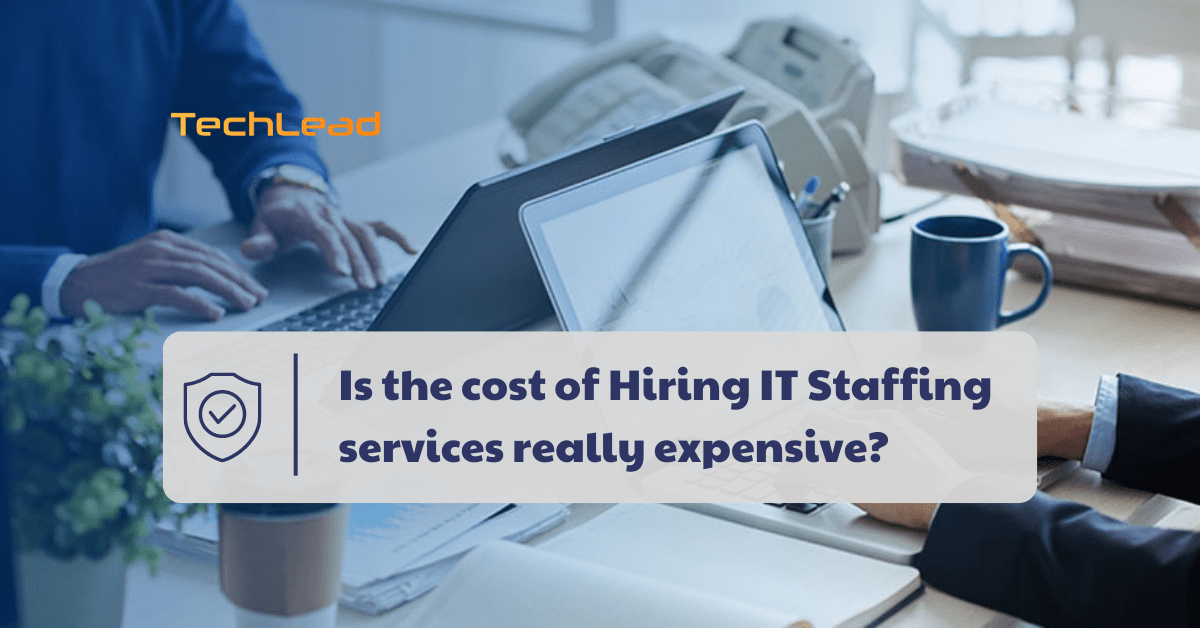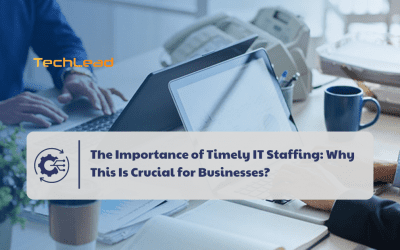In the context of digital transformation, the demand for IT staffing services is rapidly increasing as businesses seek to adapt to evolving technological landscapes. Beyond merely needing IT staffing for software development and maintenance, there’s a growing necessity for support in areas like cybersecurity, data management, and implementing advanced technology solutions. However, amidst these needs, a crucial question persists: Are the costs associated with IT staffing services truly exorbitant? This question looms large for many businesses as they weigh the decision between hiring in-house IT staff or outsourcing these services. In this article, we delve deeper into the pertinent cost factors, conducting a thorough analysis to compare the benefits and risks of each IT staffing model. Through this examination, we aim to provide readers with a comprehensive and nuanced understanding of this critical issue.
I. The Importance of IT Staffing
IT staffing play a fundamental role in maintaining and developing a business’s technological operations, helping businesses not only survive but also thrive in the digital age. They ensure the smooth operation of information technology systems and contribute to the development of new technological solutions, keeping businesses ahead in a competitive environment. The importance of IT staffing can be analyzed through the following aspects:

The Importance of IT Staffing (Collected)
1. Ensuring Continuous and Stable Operations
IT staffing are responsible for managing and maintaining information technology systems, ensuring continuous and stable system operation. Their tasks include hardware maintenance to prevent failures, software updates to ensure functionality and improved security, as well as network management to ensure smooth connectivity. As a result, businesses can avoid unwanted disruptions in operations and maximize the overall system efficiency.
2. Information Security
Cybersecurity is a critical concern for every business in the digital age. IT staffing play a vital role in safeguarding a company’s data against various cyber threats, such as attacks from hackers, malware, and data breaches. They establish and maintain security measures, such as firewalls, data encryption, and protective protocols, helping businesses maintain trust with customers and partners. Protecting data not only helps prevent financial losses but also safeguards the reputation of the business.
3. Technical Support and Troubleshooting
IT staffing provide technical support to all employees within the enterprise, addressing issues related to both hardware and software. This includes troubleshooting computer malfunctions, installing and updating software, and providing guidance on the use of technological tools. Thanks to this support, employees can focus on their core tasks without being interrupted by technical issues, thereby enhancing work efficiency and minimizing downtime due to technical glitches.
4. Application Development and Deployment
Software development and application is one of the primary tasks of IT staffing. They create technology solutions tailored to the business needs of enterprises, ranging from internal applications to optimize workflows to customer-facing products, enhancing user experience and gaining a competitive advantage for the business. This process involves designing, developing, testing, deploying, and maintaining applications to ensure they operate efficiently and meet user needs.
5. Data Management and Analysis

Data Management and Analysis (Collected)
IT staffing are responsible for managing and analyzing business data, thereby providing crucial information to support decision-making. They build effective data management systems, helping businesses store, retrieve, and analyze data easily and accurately. With well-managed data, leaders can make strategic decisions based on reliable information, enabling sustainable development and effective competitiveness.
6. Business Strategy Support
IT staffing not only work with technical aspects but also contribute to shaping the business strategy of the enterprise. They advise leadership on emerging technology trends, helping businesses apply advanced technologies to improve workflows, enhance efficiency, and expand scale. In this way, they help businesses not only maintain but also develop robustly in a constantly changing business environment.
7. Innovation and Improvement
In a world of ever-changing technology, IT staffing are the driving force behind innovation in the enterprise. They continually seek new solutions, experiment with advanced technologies, and improve current workflows. As a result, businesses stay ahead in the industry, adapt quickly to market changes, and maintain and enhance their competitive advantage.
In summary, IT staffing are not only technical support but also strategists and drivers of innovation. They help businesses optimize operations, protect data, and develop sustainably in a competitive environment, making significant contributions to the success and development of businesses in today’s digital era.
II. Forms of IT Staffing
1. Hiring In-house IT Staff
Hiring in-house IT staffingis a common option where businesses directly employ full-time or part-time IT staffing. With this approach, businesses have full control and management over personnel, from job orientation, training to performance evaluation. One of the biggest advantages of hiring in-house staff is the continuity and stability in work. However, it also comes with significant costs, including basic salary, benefits such as insurance, vacation, training, recruitment and maintenance costs, and investment in technical infrastructure.
Hiring In-house IT Staff (Collected)
2. Outsourcing through Service Providers
Outsourcing through service providers is a popular choice for businesses looking to reduce management burdens and costs. When outsourcing, businesses collaborate with specialized IT service providers who already have a rich pool of experts with diverse skills and experiences. This not only helps businesses save recruitment and training costs but also ensures work quality due to the high expertise of service providers. One of the greatest benefits of outsourcing is flexibility. Businesses can outsource for short-term or long-term projects as needed, without worrying about maintaining personnel after the project ends. However, outsourcing also has risks and challenges, such as difficulties in controlling work quality and progress, and dependence on external partners, which can lead to security and data protection issues. Selecting reliable partners and establishing clear agreements is essential to minimize these risks.
3. Hiring Freelancers
Hiring freelancers is another option, especially for businesses needing to complete short-term projects or specific tasks without long-term commitments. Freelancers are usually independent experts who work on a project or hourly basis, providing maximum flexibility for businesses. Hiring freelancers can help businesses save costs compared to hiring in-house staff or using service providers, as there are no long-term benefits or personnel management expenses. Another advantage of hiring freelancers is access to diverse and specialized skills. However, hiring freelancers also comes with its challenges. Due to remote work and lack of long-term commitment, freelancers may lack commitment and stability in work. Supervising and managing the quality of freelancer’s work is also more complex due to the lack of direct presence. Businesses need strict control measures and clear agreements on working conditions, progress, and quality to ensure the effectiveness of hiring freelancers.
III. Analysis of IT Staffing Costs
1. Cost of Hiring In-house IT Staff
Base Salary
The basic salary of in-house IT staffing typically constitutes a significant portion of the total cost. Salaries vary based on experience, skills, and job roles. Experienced IT professionals often command higher salaries, especially in specialized fields like cybersecurity, software development, or system administration. Reports suggest that basic salaries for IT staffing in major cities such as Hanoi or Ho Chi Minh City can range from 15 million to 60 million VND per month, depending on the level and specialization.
Benefits Costs (Insurance, Leave, Training)
Apart from the base salary, companies also have to bear benefits costs such as health insurance, social insurance, leave entitlements, and skill development training. These costs typically account for 20-30% of the employee’s base salary. Continuous training is particularly crucial in the IT industry to ensure that employees stay updated with the latest technologies and maintain job effectiveness.
Recruitment and Training Costs
Recruitment costs include expenses for job advertisements, recruitment agency fees, and the time spent by the HR department. This process can last from a few weeks to several months, depending on the position requirements. Additionally, companies need to invest in initial and ongoing training to ensure employees quickly adapt and enhance their skills. These costs can amount to tens of millions of VND per year per employee.
Equipment and Office Costs
To enable efficient work, companies need to provide modern technological equipment such as computers, software, and networking devices. Additionally, office costs including workspace, utilities, and other amenities are indispensable. For large enterprises, equipment and office costs can reach hundreds of millions of VND per year.
2. Cost of Hiring IT Services from Companies
Service Contract Value
The value of IT service contracts is typically determined based on the scope of work, complexity, and duration. These contracts can range from tens of millions to billions of VND, depending on the business requirements. Outsourcing IT services from professional companies helps businesses save time and optimize internal resources.
Additional Services
Besides core services, IT service companies may offer additional services such as 24/7 technical support, regular system maintenance, and advanced security solutions. These services often incur additional fees, and the total costs can significantly increase if a business requires multiple additional services.
Contract Management Costs
Managing IT service contracts also requires companies to allocate time and resources to monitor and ensure work quality. This includes regular meetings, performance evaluations, and addressing any issues that arise. While this cost may not be substantial, it is essential to ensure businesses receive the best value from the contract.
3. Cost of Hiring Freelancers
Hourly or Project-based Hiring Rate
Hiring freelancers can offer flexibility and cost savings compared to hiring full-time employees or contracting with large service companies. Freelancer rates are typically charged hourly or per project, ranging from hundreds of thousands to millions of VND per hour, depending on expertise and experience. This allows businesses to tightly control budgets and only pay for completed work.
Project Management and Supervision Costs
Although hiring freelancers can reduce direct costs, businesses still need to invest in project management and supervision to ensure timely and quality completion of work. This includes setting clear objectives, monitoring progress, and addressing any issues that arise. While this cost may not be significant, it needs to be considered to avoid potential risks and ensure work efficiency.
IV. Factors Affecting IT Service Costs
IT service costs can fluctuate significantly based on several factors. Understanding these factors is crucial for accurate cost estimation and decision-making:
1. Level of Expertise and Experience
The expertise and experience of IT staffing are primary factors affecting service costs. Personnel with high levels of expertise and experience typically demand higher salaries or service fees due to their ability to efficiently solve complex problems.
2. Project Scale and Complexity
The scale and complexity of IT projects significantly impact service costs. Larger and more complex projects require more resources, including personnel, equipment, and software. These projects often involve multiple experts with different skills, along with extended work times for completion.
3. Time and Deadline Requirements
Time and Deadline Requirements (Collected)
Time and deadline requirements for projects are critical factors affecting service costs. Projects requiring short completion times or urgent deadlines often incur additional fees to compensate for overtime work or additional resources needed to meet the deadlines.
4. Location and Labor Market
The location and labor market where a business operates also influence IT service costs. Areas with high living costs and competitive IT labor markets, such as major cities or tech hubs, typically have higher IT staffing costs. Conversely, areas with lower living costs and less labor market competition may offer lower service costs. Additionally, outsourcing from countries with lower labor costs is an option many businesses consider to save costs, although this may come with challenges related to cultural differences and time zones.
V. Comparing Costs and Benefits of IT Staffing Options
1. Comparing Total Costs Across IT Staffing Forms
When comparing total costs across different forms of IT staffing, various factors need consideration. Hiring in-house IT staffing entails monthly salary payments, benefits like healthcare and leave, recruitment and training expenses, as well as equipment and infrastructure costs. Conversely, when outsourcing IT services from professional companies, the focus is primarily on the service contract value, which may include additional services like technical support and system maintenance. Hiring freelancers may offer lower costs, but businesses must also consider project management and supervision expenses to ensure work quality.
2. Benefits of Outsourcing vs In-house Hiring
![In-House vs. Outsourcing: In-depth Comparison [2024 ]✓](https://gloriumtech.com/wp-content/uploads/2022/09/In-House-vs.-Outsourcing.jpg)
Benefits of Outsourcing vs In-house Hiring (Collected)
Outsourcing IT services offers several significant benefits compared to hiring in-house staff. One of the most significant advantages is flexibility. Businesses can adjust IT staffing levels according to project needs without concerns about layoffs or rehiring. Outsourcing also provides access to high expertise and advanced technologies without significant investments in employee training and development. Professional IT service companies often have experienced teams capable of quickly addressing complex technical issues. Additionally, outsourcing reduces internal management costs, including HR management, resource allocation, and time. This allows businesses to focus on core activities and business development.
3. Risks and Challenges of Outsourcing
While outsourcing IT services offers numerous benefits, it also comes with risks and challenges. One of the most significant risks is security concerns. When entrusting data and systems to external parties, businesses must ensure robust security measures to protect sensitive information from threats. Work quality is another critical factor to consider carefully. Not all outsourcing services meet business standards and expectations, especially when there are differences in work culture or processes. Dependency on IT service providers can also be a challenge, as businesses may struggle to replace or control the quality of work. This necessitates careful selection of reliable partners and stringent monitoring mechanisms to ensure smooth project execution and maximize efficiency.
IV. Conclusion
In conclusion, whether IT staffing costs are truly expensive depends on the specific needs of the business and the method of cost calculation alongside the benefits provided by the service. Outsourcing IT staffing can be a viable and cost-saving option if businesses manage and select suitable partners effectively. Therefore, businesses should consider factors such as project scale, expertise requirements, and completion time to choose the most suitable solution for their needs and budget.
TechLead – Leading technology solution for you!
Hotline: 0372278262
Website: https://www.techlead.vn
Linkedin: https://www.linkedin.com/company/techlead-vn/
Email: [email protected]
Address: 4th Floor, No. 11, Nguyen Xien, Thanh Xuan, Hanoi







